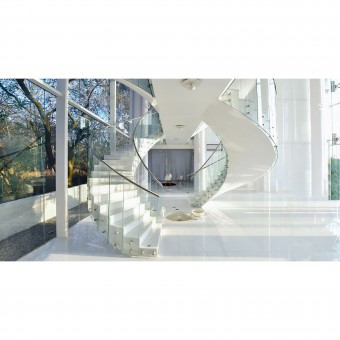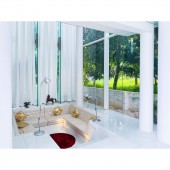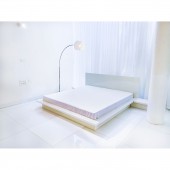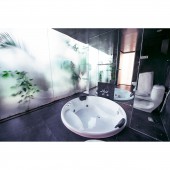
| THE AWARD |
| CATEGORIES |
| REGISTRATION |
| SUBMIT YOUR WORK |
| ENTRY INSTRUCTIONS |
| TERMS & CONDITIONS |
| PUBLICATIONS |
| DATES & FEES |
| METHODOLOGY |
| CONTACT |
| WINNERS |
| PRESS ROOM |
| GET INVOLVED |
| DESIGN PRIZE |
| DESIGN STORE |
| THE AWARD | JURY | CATEGORIES | REGISTRATION | PRESS | WINNERS | PUBLICATIONS | ENTRY INSTRUCTIONS |
The Crystal Hall Residential Interior by THOMAS ABRAHAM |
Home > Winners > Design #129709 >Interview |
 |
|
FS: What is the main principle, idea and inspiration behind your design?
TA: Crystal Hall's interiors attempt to change – or perhaps retrace – the design paradigm as we know it. For one, its aesthetic philosophy is new: Form follows Function follows Feeling. Form follows Function is a mechanistic interpretation of design, emphasizing the ephemeral (utility, stability, affordability, and durability) rather than the ethereal (that goes beyond the materialistic and the immediate). “Function alone does not drive form,” said the Shaker pioneer Mother Ann Lee, "(Rather) audience needs, client desires, ethical obligations, aesthetic inclinations, material properties, cultural presuppositions, and functional requirements” shape form. And to this, we can add Feeling – which goes beyond the designer's or client's emotions, to embrace that of nature, community, and humanity. The other philosophical underpinning here is Paleomodernism (paleo, lit. first) – returning to Design101: balance, rhythm, scale, harmony, Golden Ratios...Paleomodernism is not new: Louis Kahn's work, for example, resembled classical design without plagiarizing it. Our aesthetic preferences are timeless and yet we must imbue the place, time, and technology we inhabit, sensitive to the diversity, equity, and inclusivity of our communities, and environments.
FS: What has been your main focus in designing this work? Especially what did you want to achieve?
TA: I mainly wanted to bring about a change in the culturally dominant worldviews and set a mark for more sustainable, socially responsible and eco friendly products and practices in the field of design. As a strong believer and practicer of sustainable, socially responsible and economically effective practices, I believe that my work would serve as a catalyst in enabling people to realize that design is more than just creating something pretty.
FS: What are your future plans for this award winning design?
TA: I look forward to the Crystal Hall fulfilling its true purpose which is contributing to the society both in terms of function as well as in terms of inspiration as a landmark for innovative, sustainability and Environment First design. While the building was primarily designed as a residential unit, it's also meant to be a home office for some of its residents. In fact, some of its spaces on the outside and the inside have been designed to be used as social spaces like for literary readings, art shows, fashion shows and film shooting. Almost as soon as the building was finished, without any publicity whatsoever and though its off the beaten track – Crystal Hall, has become a magnet for architects as well as non-architects who come to enjoy the building and spend their time around it, like a tourist attraction.
FS: How long did it take you to design this particular concept?
TA: The Crystal Hall was constructed over a span of 5 years, from 2014 to 2019.
FS: Why did you design this particular concept? Was this design commissioned or did you decide to pursuit an inspiration?
TA: It was a bit of both. The client, Mrs. Thomas, the client commissioned Crystal Hall as a home for herself, a place where she can bring up her grandchildren. Thus, the building includes elements that have been religiously, culturally and geographically experienced by the family. Things like towers, water bodies etc associate with the family memory that dates to their 25 years stay in the Middle East where mosques, minarets as well as Arabian Gulf were part of their cultural DNA. The stepped well pays homage to the temple tanks and water reservoirs in India. The buildings sit on pedestals common in their home state of Kerala. In addition to this, I wanted to create something spectacular keeping in mind my design policies- sustainable and socially responsible architecture, my design philosophy - Form Follows Function Follows Feeling Follows Philosophy and my design motto- to design a better world. The Crystal Hall was the perfect canvas for this.
FS: Is your design being produced or used by another company, or do you plan to sell or lease the production rights or do you intent to produce your work yourself?
TA: I would never sell the rights to my building. It is something that is very close to my heart and too priceless to sell. A lot of work went into the whole process right from the planning to the designing to the execution. It was something that I worked on right from the most smallest things to the bigger picture. It is almost impossible to even think about the rights of the Crystal Hall going to someone else.
FS: Where there any other designs and/or designers that helped the influence the design of your work?
TA: The big idea in Crystal Hall is for art to imitate life. As such its appeal is universal and perhaps timeless, simultaneously harking back to the masters - both the work of Louis Kahn in Ahmedabad and the Taj Mahal. This is paleomodern (paleo = first) architecture – modern but inspired by history, incorporating the Golden Mean and Square proportions, variety, balance, repetition, emphasis, movement, harmony, pattern and contrast. It’s flanked by two towers that draw inspiration from the Taj Mahal’s symmetrical minarets as well as from the brick kiln towers that provide India’s primary building material. We have used stepped wells, inspired by those in India’s temple tanks, and raised our buildings on pedestals that are common here – as protection from monsoon rains, as well as to give gravitas to the architecture. The verandas pay homage to our location, Angalapura (lit: the place of verandas). They provide shade and air circulation – except that the verandas herein have glass colonnades that replicate the hypostyle halls of traditional architecture.
FS: Who is the target customer for his design?
TA: While the client was just a single person, the target customer is probably the entire world especially considering how it is a building rich in its conceptual connection to history, society and the environment, especially its life time costs and benefits with respect to social, economic and environmental value.
FS: What sets this design apart from other similar or resembling concepts?
TA: While there are a few glass buildings designed, it is almost impossible for a glass residence without windows and air-conditioning to be sustainable and yet my design does just that. In the 7 to 10 feet gap between two levels of high-performance glass, a thickset of tropical rainforest trees are encased in a sheer glass layer. The presence of the twin glass walls, along with the thick rainforest vegetation sandwiched within, cuts the heat ingress. The thick greens provide privacy to the interiors. The double glazing along with the thick greens, while keeping out the heat and enabling the ambient temperature to fall by a few notches, also insulates against external noise while ensuring copious natural light seeps into the interiors.” It is natural to infer that the residence is air-conditioned given the absence of any windows in the structure. However, there is no air conditioning in the building. Insulation is provided by the trees and high-performance glass walls. Exhausts in the ceiling pull heated air out of the room, allowing for natural ventilation.
FS: How did you come up with the name for this design? What does it mean?
TA: I came up with the name Crystal Hall because of the building’s glassy structure. My main focus with white walls and glassy interiors was on keeping the space uncluttered and minimalistic. When I saw the building situated in the haven of nature, its beautiful glass glistening in the morning light, it was the first thought that came into my mind and from then on, it just stuck.
FS: Which design tools did you use when you were working on this project?
TA: I know it is an unorthodox paradigm but as mentioned earlier I rarely make drawings, except the most rudimentary ones on a draft paper and I only make CAD drawings for construction purposes alone. Therefore the primary design tool is presentation, conceptualization to the reels or models. Except that in Crystal Hall, I made life sized models. In other words if the building element is a 50 foot library tower, I literally made 1:1 scale with bamboo tight 50feet height with white cloth surrounding it, exactly same size and shape and then I moved it around enlarging it, squeezing it to get posture of each individual element as well as the proportion of the spaces in between. This helped the client as well as the architect to visualize how exactly the building would look once it is finished, something which I think no CAD drawing, no physical model or elevation would be able to conceive because of perspective error. To finally know about what proportions you are using in drawings, every site compels a certain proportion because the surrounding so to speak commands that any building that comes within the space has the right size, shape, color and scale.
FS: What is the most unique aspect of your design?
TA: While the Crystal Hall has several areas of innovation, the one that stands out is the double layered glass. Glass is among the few building materials that can be recycled indefinitely without losing quality or clarity, thus reducing the building’s carbon footprint while contributing to the aesthetic at the same time. Though glass buildings are typical in Bangalore for commercial buildings, the Crystal Hall is a residence built entirely in glass without windows and air-conditioning, and yet is sustainable. In the 7 to 10 feet gap between two levels of high-performance glass, a thickset of tropical rainforest trees are encased in a sheer glass layer. The presence of the twin glass walls, along with the thick rainforest vegetation sandwiched within, cuts the heat ingress. The thick greens provide privacy to the interiors. The double glazing along with the thick greens, while keeping out the heat and enabling the ambient temperature to fall by a few notches, also insulates against external noise while ensuring copious natural light seeps into the interiors.
FS: Who did you collaborate with for this design? Did you work with people with technical / specialized skills?
TA: For me, a major philosophy that I live by is giving back to the society in any way I can. And so, socially responsible design is of great importance to me in whatever I am doing. Many of the employed people both during and after the building of the villa were youth who hadn’t embarked on their professional journey yet. This gave the whole thing a new perspective, and while it proved immensely beneficial for the project, it also catalyzed their career advancement. And I didn’t just stop with the youth. I employed the local underprivileged from the poorest sections of the society, thus giving them the opportunities, they lacked but deserved.
FS: What is the role of technology in this particular design?
TA: The Crystal Hall is a building of dialectic opposites. On the one hand, it is inspired by history, what I call paleomodern architecture and yet it is also one of the most technology up to date buildings of its genre at least in its location. It has probably the world’s free standing windmill towers that you see on windmill farms to generate power. It probably has the first usage of a double layer of high performance SD167 glass with a 10 foot sandwich of rainforest between. It also uses the most up to date ethos in terms of recycling, up cycling and reduction of waste. It has near net zero carbon footprints and is socially, ecologically and physically responsible building. The point was to be so technologically advanced as to use the minimum amount of technology as for example in the air conditioning, to keep it as passive as possible that for most of the year and most of the day, you need no air conditioning and no artificial lighting.
FS: Is your design influenced by data or analytical research in any way? What kind of research did you conduct for making this design?
TA: Special respect to climatology, heat transmission and the performance of glass as well as the heat radiation with respect to vegetation, we did an extensive amount of research which is why we are able to design in such a way that the first layer of glass allowed only 35% of the heat to pass through, and then the intermittent rainforest between further emitted 60% of the remaining heat and of this residual heat , a further 60% was dispersed by the second layer of glass such that as per our research and calculations and measurements, almost 72% of the exterior heat was prevented by the interiors. Similarly a lot of research went into wind speeds and electricity generation by wind allowing us on good days to feed energy back to the city grid thus keeping our net energy consumptions substantially carbon neutral. Similarly a lot of research went into local and natural vegetation, both around the building as well as within it because as per recent research, this has paved off because the site has become a magnet for native flora and fauna like peacock, deer, mongoose and owls.
FS: What are some of the challenges you faced during the design/realization of your concept?
TA: A key concern was about building a residence entirely in glass without windows and air-conditioning while ensuring it is sustainable. To combat this, in the gap between two levels of high-performance glass, tropical rainforest trees are encased providing privacy and insulation while cutting the heat ingress. Also, exhausts in the ceiling pull heated air out of the room, allowing for natural ventilation. Another challenge was the difficulty non-architects or the clients have in visualizing the finished structure, and so I decided to create full-size models on the site. As proportions are often distorted by perspective in real-life conditions (and are impossible to replicate in CAD drawings/ small scale models accurately), reusable 1:1 models of bamboo-and-cloth were resized and moved around to get the exact shapes and proportions of the various buildings. However, these bamboo sticks and cloth were reused later in the construction, creating zero wastage.
FS: How did you decide to submit your design to an international design competition?
TA: To be quite honest, I had planned to submit the Crystal Hall for the A’ Design Award right from the time of its conception. It was something I looked forward to especially because of its philosophy which aims to recognize, communicate and promote good design, creators and companies. I always wanted to participate in the awards and so being a part of the whole thing and winning an A’ Design award is one of the greatest achievements a designer can have. It is a certificate of excellence and a matter of pride and I feel so honored.
FS: What did you learn or how did you improve yourself during the designing of this work?
TA: While I undoubtedly learned the aspects, the limitations and the potentiality of material and technology, my biggest learning curve was in teamwork and being humbled by the incredible contribution of smallest members of the team because you realize that without everybody’s fullest passion, the Crystal Hall would simply be impossible. Whether it be the client or whether it be the gardener or for that matter whether it be the weather or the tangible, the intangible, the animate, the inanimate, all of these together, the human and the natural, all of it came together and I found this symbiosis of the coming together almost serendipitous, almost as if the Crystal Hall was meant to be.
FS: Any other things you would like to cover that have not been covered in these questions?
TA: An architect with an Honors from IIT, Kharagpur (among India’s premier educational institutions), My work extends across the creative fields of fashion, furniture, interiors, architecture, art and writing. My work is grounded in social and environmental consciousness, embracing sustainability, recycling, low carbon footprints and employing poor indigenous people of color. I have been on the press and media across the world including being featured in NBC and FOX 40 in USA, Marketwatch in Netherlands, The Morning Star in China as well as International Business Times. I have won 27+ awards including World Architecture Award, Platinum Muse Design Awards and the International Design Award. I was also a finalist at the Indian Institute of Architecture Awards and the Society of British and International Interior Awards (where I was the only Indian finalist). And, now I'm honored to receive a Bronze Award from A' Design Award. In addition to this, I also run two successful award winning education ventures – IDeA World Design School, which is India’s oldest privately run design school and has also won the award for Best Design Education at the Business Times Awards and Giraffe Learning where I am an the Founder- Chancellor and have mentored over 45,000 students. I also instituted IIT Kharagpur’s first peer to peer award, The April Ann Prize for the Highest Achievement in Creative Enterprise which celebrated its 25th anniversary recently.
FS: Thank you for providing us with this opportunity to interview you.
A' Design Award and Competitions grants rights to press members and bloggers to use parts of this interview. This interview is provided as it is; DesignPRWire and A' Design Award and Competitions cannot be held responsible for the answers given by participating designers.
| SOCIAL |
| + Add to Likes / Favorites | Send to My Email | Comment | View Press-Release | Translations |




